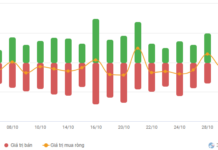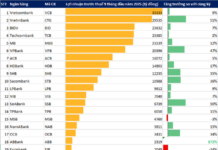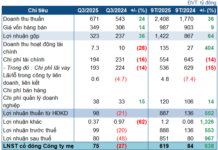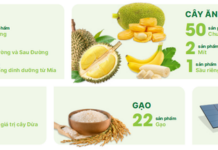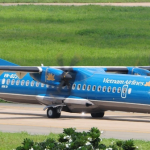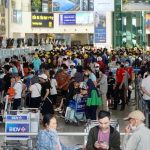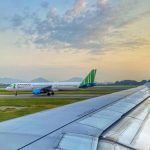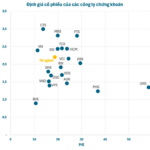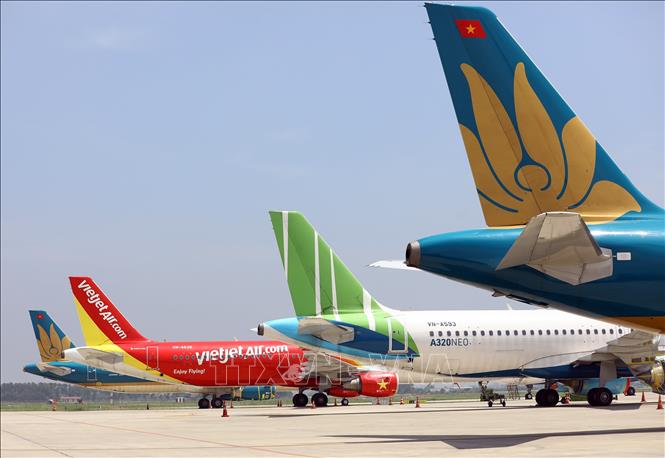
Aircraft of airlines at Noi Bai International Airport. Photo: Huy Hung/VNA
According to statistics from the Civil Aviation Authority of Vietnam, as of July 2024, the total number of aircraft operated by Vietnamese airlines with a valid Air Operator Certificate (AOC) stood at 195, a decrease of 36 aircraft compared to the previous year.
The average number of aircraft in operation was 167, a decrease of 51 from 2023. In 2023, the ratio of aircraft in operation to the total number of AOC-certified aircraft was 94.4%. However, due to aircraft engine recalls by manufacturers, this ratio dropped to 85.6% in 2024.
Meanwhile, the Civil Aviation Authority of Vietnam forecasts that the total air transport market in 2024 will reach approximately 78.3 million passengers and 1.21 million tons of cargo, representing a respective increase of 7.7% and 13.4% compared to 2023.
To meet the rising demand for domestic air travel, Vietnamese airlines have been actively leasing aircraft in recent times.
Since the beginning of the year, Bamboo Airways has wet-leased three aircraft, focusing on popular tourist routes during the summer holidays, including connections to Nha Trang, Da Nang, and Quy Nhon.
Luong Hoai Nam, CEO of Bamboo Airways, shared that the airline has been working diligently to negotiate with partners worldwide to expand its fleet. The company plans to lease an additional aircraft by the end of the year to introduce new domestic routes, such as Ho Chi Minh City to Da Lat, Thanh Hoa, and Phu Quoc, enhancing passenger convenience.
Vietnam Airlines’ CEO, Le Hong Ha, predicted that the shortage of aircraft could extend into 2025. The airline has implemented various solutions, including temporarily suspending or reducing frequencies on less profitable routes during off-peak seasons, increasing flight hours, and wet-leasing several aircraft. During the Tet holiday peak season, they leased two additional planes and plan to lease five more by the end of the year.
Vietnam Airlines is committed to optimizing its operations by focusing on early morning and late-night flights with attractive fares. Moreover, the airline is set to induct new Airbus A320neo and Boeing 787-10 aircraft into its fleet this July.
Previously, Vietnam Airlines reported high load factors, ranging from 75-94%, for flights departing between 9 PM and 5 AM to key tourist destinations like Hanoi, Ho Chi Minh City, Da Nang, Nha Trang, Da Lat, Quy Nhon, and Phu Quoc during May and June.
Vietjet, another prominent Vietnamese carrier, plans to induct ten new aircraft by the end of the year, including eight A321neo and two E190 jets. In 2025, the airline expects to receive additional A321neo, A330-300, E190, and Boeing 737 MAX aircraft.
However, Do Hong Cam, Deputy Director of the Civil Aviation Authority of Vietnam, pointed out the challenges faced by airlines in securing leased aircraft due to increased leasing rates. Additionally, rising fuel prices and unfavorable exchange rates have also impacted the industry, affecting supply and contributing to fluctuations in domestic airfare prices.
Le Anh Tuan, Deputy Minister of Transport, acknowledged the difficulties faced by the aviation industry, including aircraft shortages, route restructuring, rising fuel prices, and unfavorable exchange rates.
Regarding the issue of aircraft engine recalls, the Deputy Minister requested that airlines clearly communicate their plans and the support required from the government. He also instructed relevant units to explore solutions, which the Ministry of Transport will compile and report to the Prime Minister to ensure safe and seamless air travel for passengers.
In the first six months of the year, the industry transported approximately 37.5 million passengers, a 3.7% increase compared to the same period in 2023, and equivalent to 96% of the pre-pandemic figure in 2019. Notably, international travel showed a strong recovery, with a passenger volume of 20.2 million, a 38.6% increase compared to 2023 and on par with 2019 levels.
In terms of safety, the International Civil Aviation Organization (ICAO) assessed Vietnam with an average score of 77.1%, an 11.54% improvement from the 2016 evaluation. This places Vietnam among the countries with higher safety standards than the Asia-Pacific and global averages (65.31% and 68.81%, respectively)
Bamboo Airways Aims High: Targeting an Impressive 18-Aircraft Fleet by 2025
Bamboo Airways has ambitious plans to expand its fleet, with a target of 12 aircraft by the end of 2024 and a further increase to 18 by the close of 2025, market conditions permitting. This forward-thinking strategy underscores the airline’s commitment to growth and its confidence in the market’s potential.


